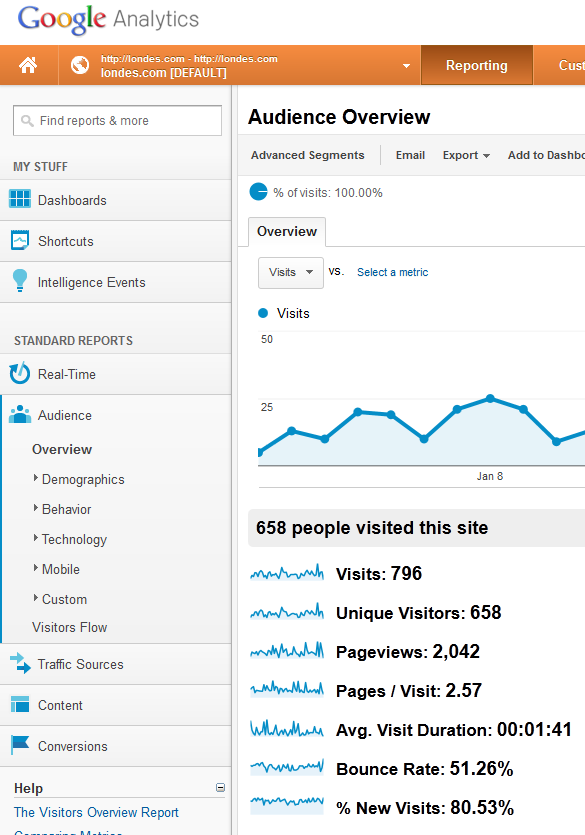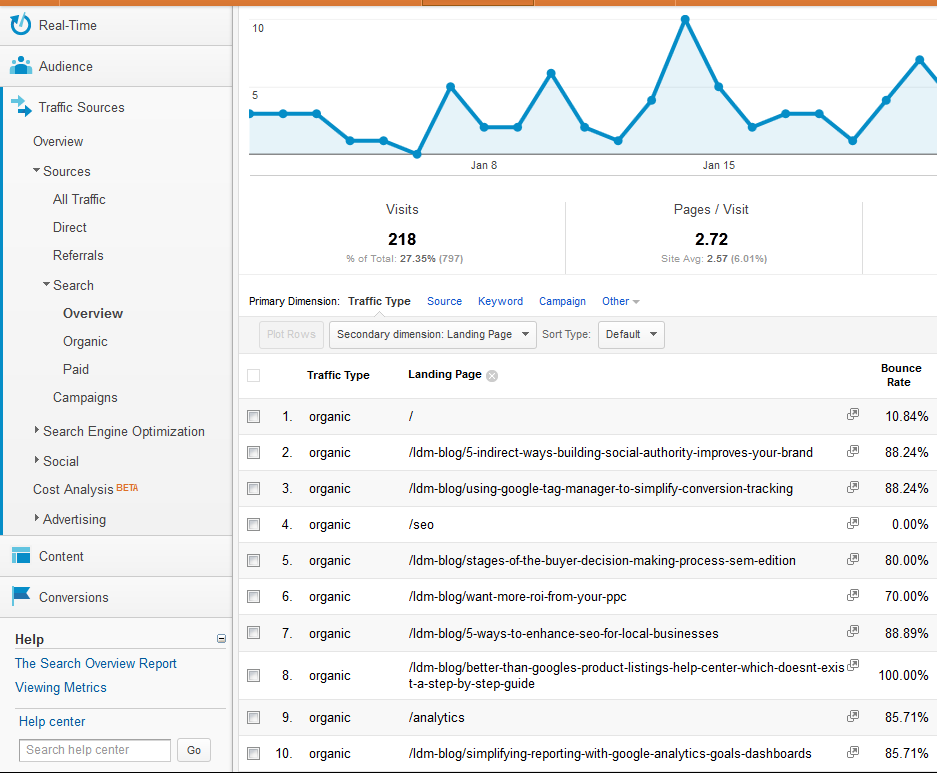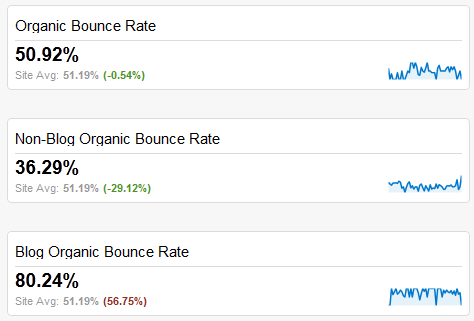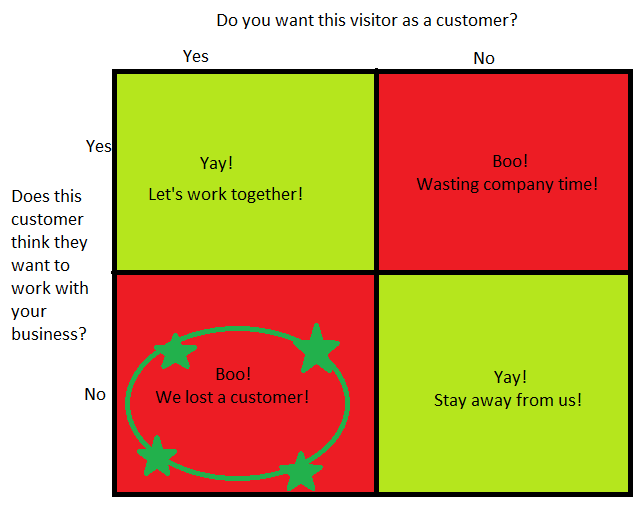- By: Mike LaLonde
- February 19, 2013
Website Bounce Rate Analytics: Using Google Analytics to Understand User Segments
Usability and engagement metrics have come a long ways. If you’re running an e-commerce store, gathering leads, or encouraging social engagement, there are a lot of more advanced metrics to look at than the time people are spending on your site, and how many pages people are viewing. From video views and jQuery interaction to Likes and Retweets, there’s a lot to measure.
But that doesn’t mean your classic usability and engagement metrics are completely useless. Even on sophisticated web presences these metrics are useful, while more basic websites may rely more heavily on them.
Bounce Rate is probably the most basic engagement metric. Everyone has heard about it. A lot of people have a general understanding. Less really understand it, and even fewer know why, where, and when we should be concerned with it.
So, let’s learn all about bounce rates.
We’ll go over the basics, then I’ll take you through an analysis of the LDM Website to show you the kind of information you can get just from monitoring bounce rates.
What is Bounce Rate?
Bounce rate is the percentage of visitors who view one page on your website and leave without any interaction. For most basic websites, this just means they viewed one page and left.
If you have event tracking (hovers, video views, button clicks), if users interact with one of them before leaving, it doesn’t count as a bounce.
Bounce Rate in Google Analytics
Finding the overall site bounce rate in Google analytics is a pretty simple exercise. It’s actually right in the default area. On the right side of the navigation (in the 2013 version of Google Analytics), in the “Audience” section you can click on “Overview.” Which, as I said, is where you are as soon as you log in.
Ours is 51.26%. Someone might call that acceptable. Most bounce rates are between 35%-55%, depending on a number of factors. But I don’t care at all about the number, and you shouldn’t either. I’ll tell you why.
It’s more useful to look at bounce rate as a page metric, rather than a website metric. Asking “what is my website bounce rate?” is a bad question. It’s also very frequently asked. The answer to that questions is this:
“It’s complicated.”
I like to say “it’s complicated” because saying “that’s the worthless question” or “who cares” isn’t a great way to make friends. The better question is “what does the bounce rate mean on a certain page based on the traffic that is landing there?”
Bounce rate isn’t just a measure of page engagement effectiveness. It’s also an indicator of visitor quality.
Bounce Rate by Traffic Source
Let’s jump back in Google Analytics for a moment. Under “Traffic Sources” choose the “Sources” drop-down, and select “All Traffic.” You’ll see a list of the different websites and mediums driving traffic to your website. Ours is pictured below (I removed a few columns so you can concentrate on bounce rate):
Now this is more interesting information. Instead of trying to judge the quality of my website based on bounce rate, I’d rather judge the quality of the traffic based on bounce rate. It’s better to look at the type of visitor I’m getting from relevant places, and judge accordingly.
LinkedIn visitors are viewing our profile or company and coming to check us out. A 13% bounce rate is great, but it isn’t really that surprising. Visitors from Google+ are likely viewing a blog or resource we produced to increase their knowledge. In general, they read it and leave. So the 86% bounce rate, while high, isn’t entirely surprising either (although I’d like it to be lower)
Bounce Rate by Organic Landing Page
Since bounce rate is a page metric, we can take a look at its value on each page. I decided to take a look at ours by landing page. In order to do that, go to Traffic Sources -> Search -> Organic. In the “secondary dimension” section of the main viewing area, select Landing Page. This will segment organic traffic by the page that the user clicks on in the search engine to view your website.
When our home page ranks and people click to visit us, we’ve got a 10.84% bounce rate. Pretty good. I’m going to save you the process, but most of these search terms are branded searches, and digital marketing agency searches (and tons of those darn “not provided” searches). So it’s not really that surprising.
Same thing goes for the SEO page. 0% bounce rate. Even better.
But look at all the URL’s that start with “ldm-blog”. Blogs have a higher bounce rate. That makes sense. They find our resource, maybe this one, by searching for “Learn about bounce rates”. They read the article, and they leave. Of course we’d rather they didn’t, but you can expect a higher bounce rate.
I created some advanced segments in a custom organic dashboard and found these bounce rates for blog traffic vs. non-blog traffic:
As I was saying regarding the difference between Google+ and LinkedIn, the organic traffic backs it up as well. If you have a blog full of specific resources, your bounce rate on those pages is going to be higher.
So what is the website bounce rate?
I think you can tell how I start to answer this question. If you’d like, I’d love to answer it in even greater detail for your website (check out our web analytics consulting services).
Understand the type of visitors that are coming to your website, make smarter usability assessments, and establish reasonable goals based on them. The more you are able to segment users and analyze usability data, the better you’ll be able to use your data.
How can you use segmented bounce rate data?
I’ll help simplify this process a little bit more for you. Let’s look at a basic Type 1 / Type 2 error chart that maps out the customers you want, versus the customers that are going to your website. By segmenting users and observing bounce rates (and your other basic usability metrics if you want), we can identify what action should be taken to optimize your web presence.
Our graphic designer is busy. But you’re in luck. I know how to use paintbrush.
Why Do Users Bounce?
I’m going to simplify why users bounce into 1 of 2 very broad categories.
1. The visitor is not in your target market (low visitor quality – they are not a perspective buyer)
This group is represented by the right column in the customer chart above. You don’t want to work with this customer. There’s absolutely no way this customer is going to buy anything from you or use your service. Maybe they have no interest at all, the price could be too high, you might specialize in something else, etc. Whatever it is, this type of visit is really just wasting everyone’s time and money.
Why it’s a problem:
Wasting company time: Think of it like calling up our company and asking if we have any SEO packages for $10/month.
Wasting advertising budget: If you are running a paid campaign to drive this traffic, or investing in SEO, then you’re wasting money attracting these visits.
Why it might not be a problem:
Before our website was a digital marketing agency, it used to be a collectable card game website. We occasionally still get people looking for that old site, or visitors clicking old links that no longer exist and are redirected to our home page (at no cost to us).
Quite frankly, I don’t care when these people bounce. They aren’t looking for digital marketing services, so it’s acceptable that my bounce rate is a little higher due to visitors like this. Does it make our overall bounce rate look worse? Sure. But it really doesn’t matter to the business.
2. Your landing page is lousy
In consultations, I would recommend going with “doesn’t appeal to the tastes or preferences of the user.”
These visitors are represented by the left side of the above chart. Despite the lousy website, if they’re still happy to work with you, they won’t bounce and you’re in good shape. But sometimes, they do bounce (or in a broader sense, abandon your conversion funnel).
This is where it’s a real problem. If the people you’re driving to your website are customers that you actually want, you need to convert them. Whether it’s poor design quality, confusing navigation, or poor messaging, you’ve got to get you website fixed up so people stay. Targeted visitors abandoning a website is one of the most overlooked ROI losses, so checking bounce rate on targeted visitors to increase engagement is vital.
What can you do about it?
Figure out why your website isn’t resonating with your target market. Maybe your website looks cheap, but you’re a premium service provider charging higher rates. That count lead to a disproportionate number of upper-right box errors, wasting your time. Maybe your design and presentation is fine, but your call to action is not compelling. What you’ve got to do is test alternatives.
I’m not saying you need a redesign. Try a different call to action. Feature a different product. Test a different headline. Evaluate your navigation and make sure your headers are appropriate. Get important content above the fold.
Test different alternatives to try to gain the interest of your target market when they visit the website. Lead them directly where they want to go, engage their visit, and lead them through the conversion funnel. If you can’t catch their interest, you’re bounce to lose a lot of customers.
Should you hire a web analytics specialist?
Some people are probably reading this thinking I’m making a mountain of a mole hill. For many small businesses, there’s some truth to that. After all, it took me 1800 words and 5 diagrams to give you a proper introduction to bounce rates. Some small businesses might just benefit from looking at bounce rates on their major pages and trying to reduce them to get a few conversions. It isn’t worth hiring someone to analyze it. There just isn’t a big enough pay-off.
But if you’re managing a marketing budget, this stuff is important. Detailed segmenting is and smart analysis can turn companies into industry leaders. Better segmenting, maximizing efficiency, allocating budgets effectively, and understanding user behavior are integral to obtaining and maintaining a competitive advantage.
If you decided to work with us, you can bet we take detailed looks at your web presence and carefully analyze all the useful information we can to make your business more effective. If you’re interested in discussing what we might be able to do for you in more detail, contact us today and we’ll go over how we might be able to help.




